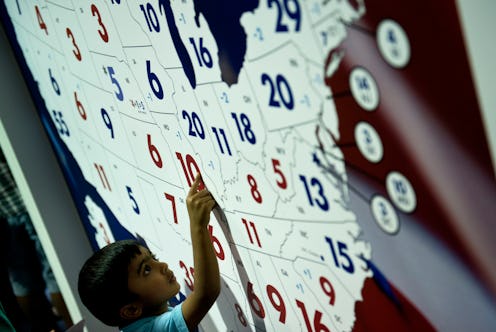News
Clinton's Electoral Map Was Set In 2008
After that brief blip where everyone freaked out about tightening polls, the presidential race is returning to where it was a few weeks ago, before Hillary Clinton's pneumonia collapse. A recent national poll by Farleigh-Dickinson University showed Clinton up by 9 percent after her impressive debate performance on Sept. 26. According to political soothsayer Nate Silver's calculations at FiveThirtyEight, it is now very likely that Clinton will win the White House (78.8 percent) and not impossible that she could win it in a landslide.
Of course, much of that is likely the result of Donald Trump, his controversial policies and inflammatory rhetoric turning off many voters while his lack of discipline stops him from convincing new ones. But if you look closer at some of the finer points of polling (which, if you're as nerdy as I am, you totally do, for fun!), there are bigger changes at work in the American electorate than just Trump's weirdness. The outcome of this election might not have been chosen when Trump became the Republican nominee. It might go all the way back to when Barack Obama won the Democratic nomination in 2008.
Back in 2008, it was considered a shock that Obama was able to win Virginia, which hadn't gone Democratic since 1964, and North Carolina, which hadn't since 1976. In 2016, Virginia is considered basically a lock for Clinton (partially due to her running mate, Virginia Sen. Tim Kaine), and she holds a slight edge in North Carolina, despite Obama losing the state in 2012. She's actually been doing better there than in Ohio, which Obama won by 3 percent in 2012. And the difference lies in what types of voters are starting to define the two parties.
Trump is doing better than any candidate in recent history with one group of Americans: white men without college degrees. Among non-white voters, among women, and even among white voters with higher education, Trump is losing. And while part of that has to do with Trump's specific campaign of white grievance, Trump is actually speeding up a demographic divide in the parties that was already happening, at least since the Democratic Party nominated the first African-American president. Even before that, the Republican Party has long been shifting toward being older and whiter, more rural and Christian, while the country as a whole (and the Democratic Party) has been doing the opposite.
So what we're seeing is that the "red" state of North Carolina is becoming a better fit for the Democratic Party with its large African-American population and high education than "swing" state Ohio. And these two states reflect the bigger change that's been happening in American politics over the past decade — the Republican Party is holding onto a white majority that doesn't exist anymore, while the Democratic Party is gobbling up the voters left out of that.
